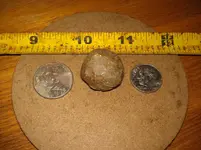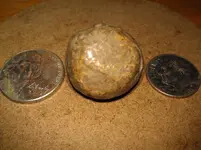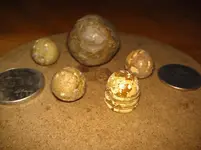Rogue Relic Hunter
Hero Member
- Joined
- Oct 3, 2016
- Messages
- 746
- Reaction score
- 592
- Golden Thread
- 0
- Location
- Virginia Colony
- Detector(s) used
- DETECTORS: XP Deus WS-4, Garrett AT Pro and Pro-Pointer, Fisher CZ-5
TOOLS: Piranha shovel & R85 Military digger, both by Predator Tools
ATTIRE: Red Head brand Knee-High Waterproof Snake Boots
- Primary Interest:
- Relic Hunting
I dug this musket ball (?) this afternoon.
It is not perfectly round in the sense that there are flat spots all over it (otherwise is round). It is very heavy. I do not currently have a way to measure it properly. Clad nickle and dime are for sizing. it is about 3/4 of an inch long (when resting on the desk) 3/4 inch high. it is not magnetic.
I dug it in an urban area where I normally find clad change and stuff that looks like the area may have been a car garage or mechanic shop of some type. However, this entire area is littered with civil war artifacts. bullets and musket balls could be anywhere you dig.
any ideas, hypotheses, and informed speculations are WELCOME! Feel free to chime in!


PIC BELOW: Musket ball (?) is center. The other balls I dug this month on separate digs. the bullet is still yet to be ID'd for sure. Wanted to include for sizing purposes on the musket ball (?). The 3 rounds balls are either case-shot or pistol shot, still to be determined. Chime in on any of these...

I did find this information online that may explain the flat spots?:
"Musket balls have been excavated at Monmouth with shallow circular depressions as shown in Figure 5. Again based on the personal experiences of the author in firing black powder flintlock muskets, this appears to be ramrod marks. Even though a ball may be sitting loosely in the breach of a musket, you still ram it several times to compact the powder. If the ball is loose, it will rotate slightly with each strike. This ball has three blows from a ramrod."
It is not perfectly round in the sense that there are flat spots all over it (otherwise is round). It is very heavy. I do not currently have a way to measure it properly. Clad nickle and dime are for sizing. it is about 3/4 of an inch long (when resting on the desk) 3/4 inch high. it is not magnetic.
I dug it in an urban area where I normally find clad change and stuff that looks like the area may have been a car garage or mechanic shop of some type. However, this entire area is littered with civil war artifacts. bullets and musket balls could be anywhere you dig.
any ideas, hypotheses, and informed speculations are WELCOME! Feel free to chime in!


PIC BELOW: Musket ball (?) is center. The other balls I dug this month on separate digs. the bullet is still yet to be ID'd for sure. Wanted to include for sizing purposes on the musket ball (?). The 3 rounds balls are either case-shot or pistol shot, still to be determined. Chime in on any of these...

I did find this information online that may explain the flat spots?:
"Musket balls have been excavated at Monmouth with shallow circular depressions as shown in Figure 5. Again based on the personal experiences of the author in firing black powder flintlock muskets, this appears to be ramrod marks. Even though a ball may be sitting loosely in the breach of a musket, you still ram it several times to compact the powder. If the ball is loose, it will rotate slightly with each strike. This ball has three blows from a ramrod."
Last edited:



